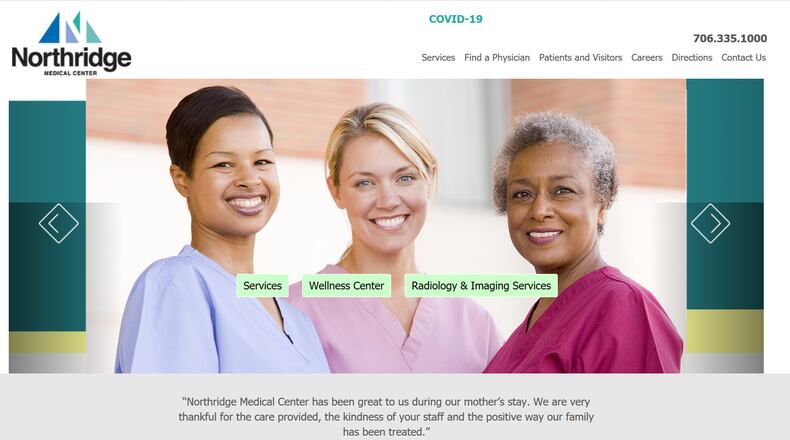One of the state’s top healthcare lobbyists is predicting that numerous rural hospitals may soon be forced to close as the pandemic continues to take a toll on the poorest and most vulnerable communities in Georgia.
“We’re in unprecedented times, and it’s putting a lot of stress on our hospitals,’' said Monty Veazey, president of the Georgia Alliance of Community Hospitals. “We could have as many as a dozen (hospitals) close in the next few months.”
Veazey’s comments were prompted by announcements of the anticipated back-to-back closures of two rural hospitals.
This week, officials at Northridge Medical Center in Commerce announced the closure of their 90-bed acute care hospital northeast of Atlanta. Late last month, officials at Southwest Georgia Regional Medical Center announced the closure of the Cuthbert facility, with the pressures from COVID-19 pushing it finances over the brink.
The closures are scheduled within roughly a week of each other. The Cuthbert hospital expects to cease operations Oct. 22, the Commerce hospital on Oct. 31.
“The decision to close and cease hospital operations was not one made lightly and only comes after exhausting all options to identify a sustainable path forward,’' said Amy Abel, a spokeswoman for the entities that control the Commerce hospital, a wholly owned subsidiary of Home & Community Services Inc., a Georgia nonprofit.
As part of the deal, a 167-bed skilled nursing center adjacent to the hospital, known as Northridge Health and Rehabilitation Center, is to remain open, Abel wrote in response to questions from The Atlanta Journal-Constitution.
Jerry Wise, hired a little over a year ago as administrator at Northridge Medical Center, did not respond to requests for comment.
Losses mount
Like Southwest Georgia, the Commerce hospital has been in financial trouble for years, an auditor’s report showed.
Like Southwest, it had few inpatients. The average daily census at Northridge was about three inpatients, Medicare records show.
It’s not too difficult to notice other signs that a rural hospital is in financial trouble, Veazy said.
The hospital usually will have trouble securing lines of credit. There will be little cash on hand to support payroll.
And the hospital will experience significant turnover in leadership, he said.
What sets the two facilities apart, though, is critical.
Jackson County residents have better access to highways and roads, which can allow them to seek healthcare at larger facilities, such as Piedmont Athens Regional Medical Center, Northeast Georgia Medical Center in Gainesville and Northside Hospital Forsyth. Median household income is also significantly higher in Jackson County.
In contrast, the Cuthbert community is more geographically isolated, without access to as many healthcare choices. The next nearest hospital is more than 30 miles away.
Randolph County, which is served by Southwest, also has larger numbers of poor and uninsured residents, according to reports filed with the Centers for Medicare & Medicaid Services.
Randolph has another distinction. It is among U.S. counties where the majority of residents are African-American and more than 5 percent are age 85 and older, according to a study by the University of Minnesota Rural Health Research Center.
Carrie Henning-Smith, who authored the study, said she was alarmed when she learned the hospital was to close. At one point in April, the county, which has a population of about 7,700, had the highest rate of infections among Georgia counties.
“My heart sank,’' Smith said.
Federal support
Federal dollars have tried to soften the blow.
Earlier this year, nearly two dozen critical access hospitals with 25 beds and less in Georgia received nearly $52 million in advanced federal relief payments. Many of the Georgia hospitals also received loans under the Payment Protection Plan.
But it hasn’t been enough to pull many out of danger, one healthcare consultant said.
The operating margin median of those hospitals that received advanced payments was 0.7%, according to research compiled by The Chartis Center for Rural Health, which has offices in Atlanta. The report also found that those hospitals on average had as few as 34 days cash on hand.
In a recent survey of rural hospital administrators across the U.S., many said they were unsure if finances would improve as pressures from the pandemic eased, said Michael Topchik, national leader for Chartis.
“Almost all of them made a comment that we don’t know what our financial position will be moving forward, but we started in a tough spot and now things are more uncertain,’' Topchik told the AJC.
On Thursday, the U.S. Department of Health and Human Services. announced it would provide more than $35 million to an additional funding to 50 rural organizations in more than 33 states.
About the Author
Keep Reading
The Latest
Featured



